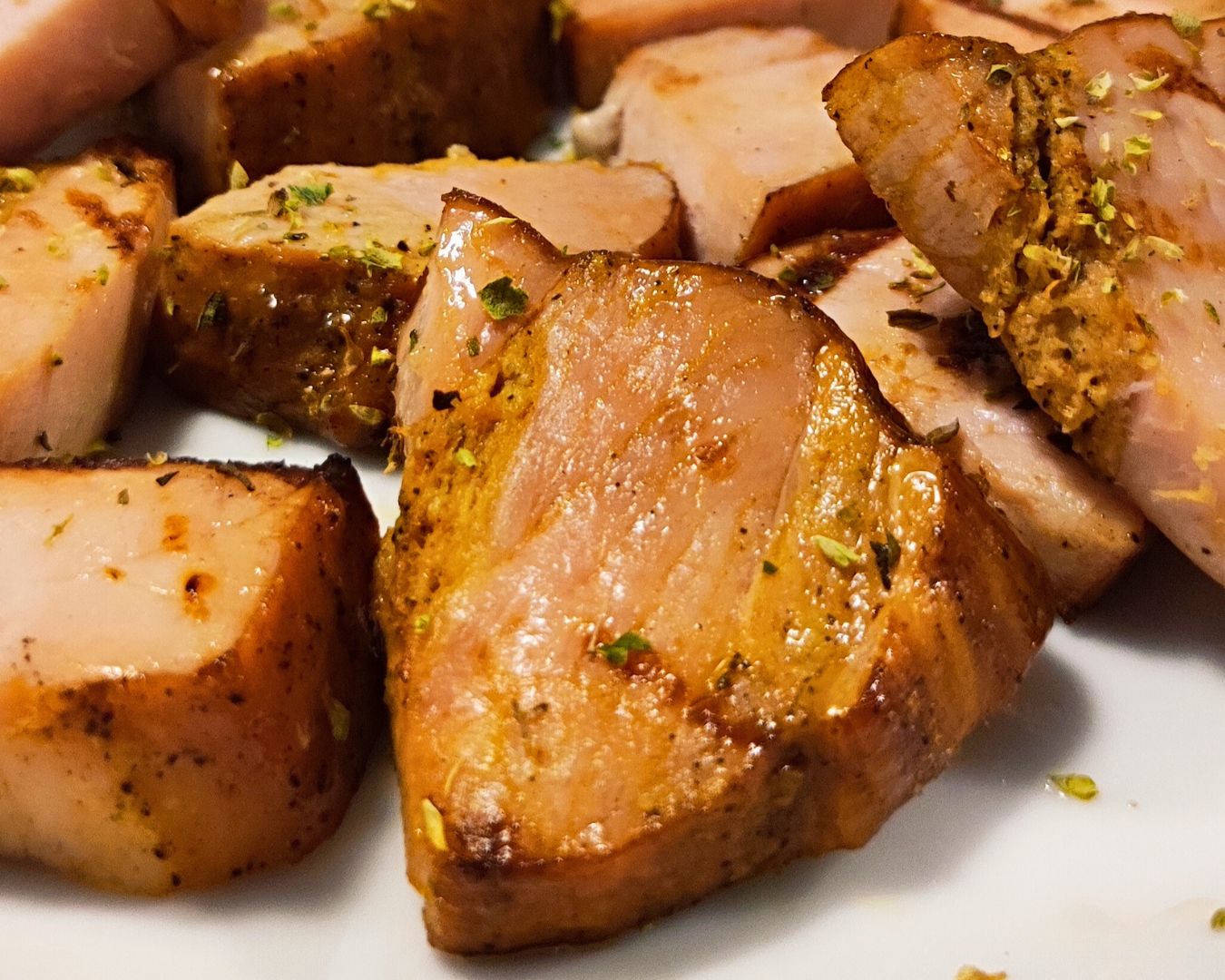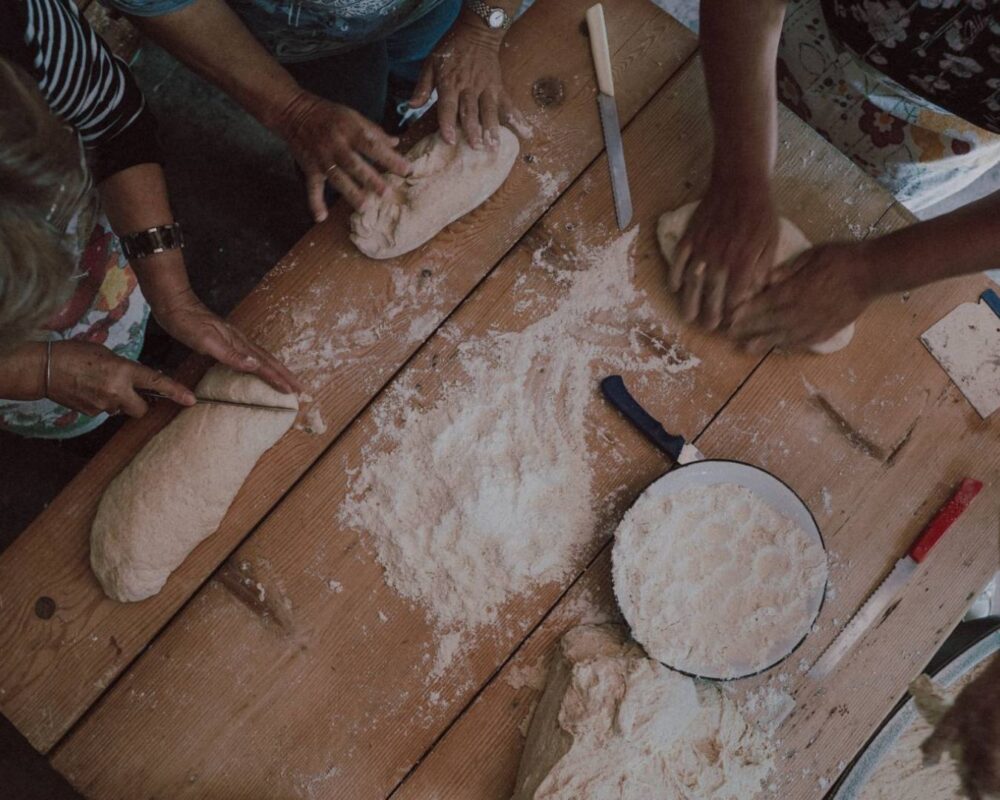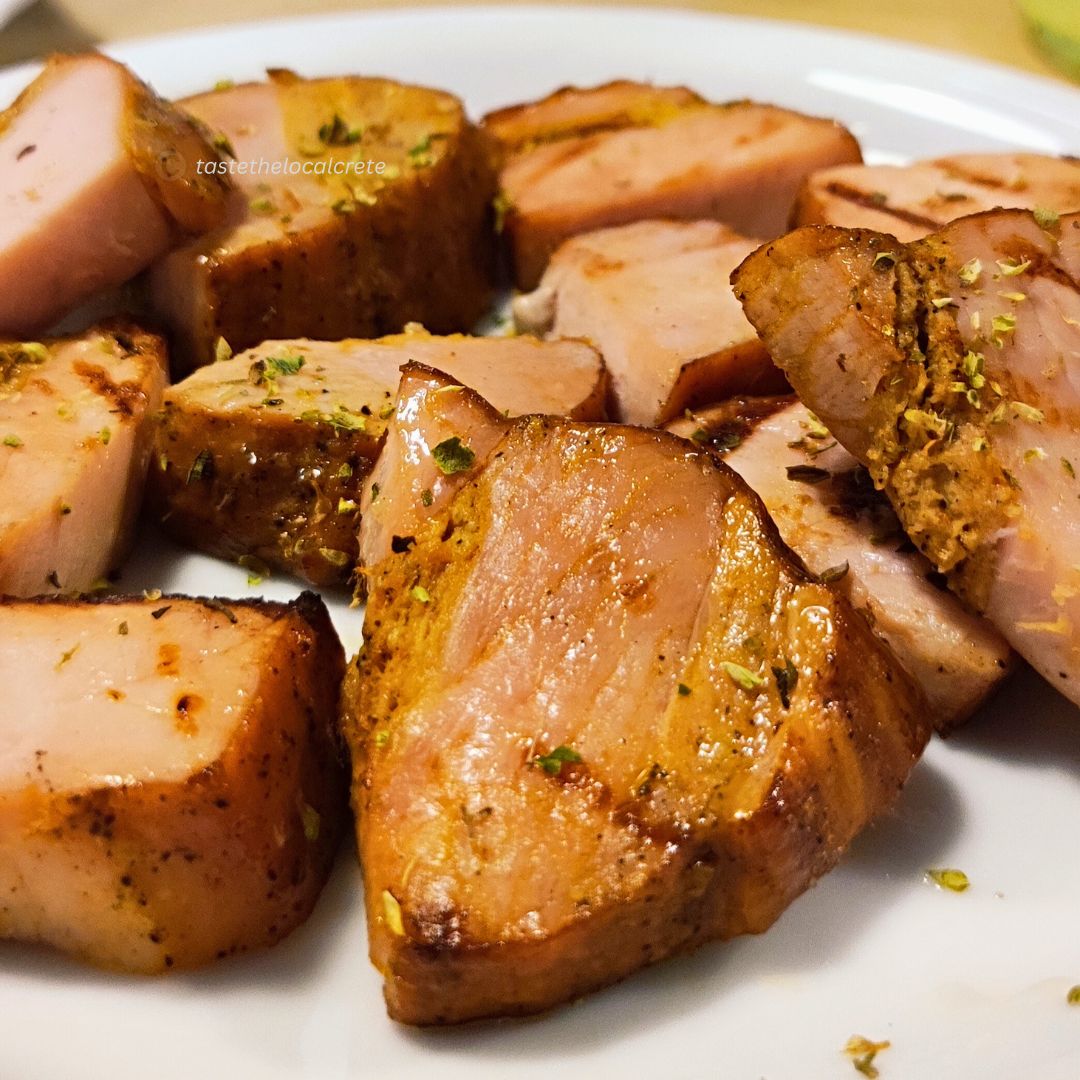
Welcome to Crete’s “weird” food scene.
These dishes might look intimidating at first glance, but they’re actually delicious examples of traditional Crete foods that are worth trying.
Cretan cuisine emphasizes simple preparations that allow quality ingredients to shine. What looks unusual to outsiders often represents the island’s most authentic flavors and centuries-old preservation techniques.
Ready to explore the adventurous side of Cretan cuisine?
And once you’re done reading about them, you can dive into the everyday dishes locals actually cook at home with the digital Cretan cookbook created by Taste the Local Crete – packed with 50+ authentic recipes you can easily use on your smartphone, tablet, or laptop.
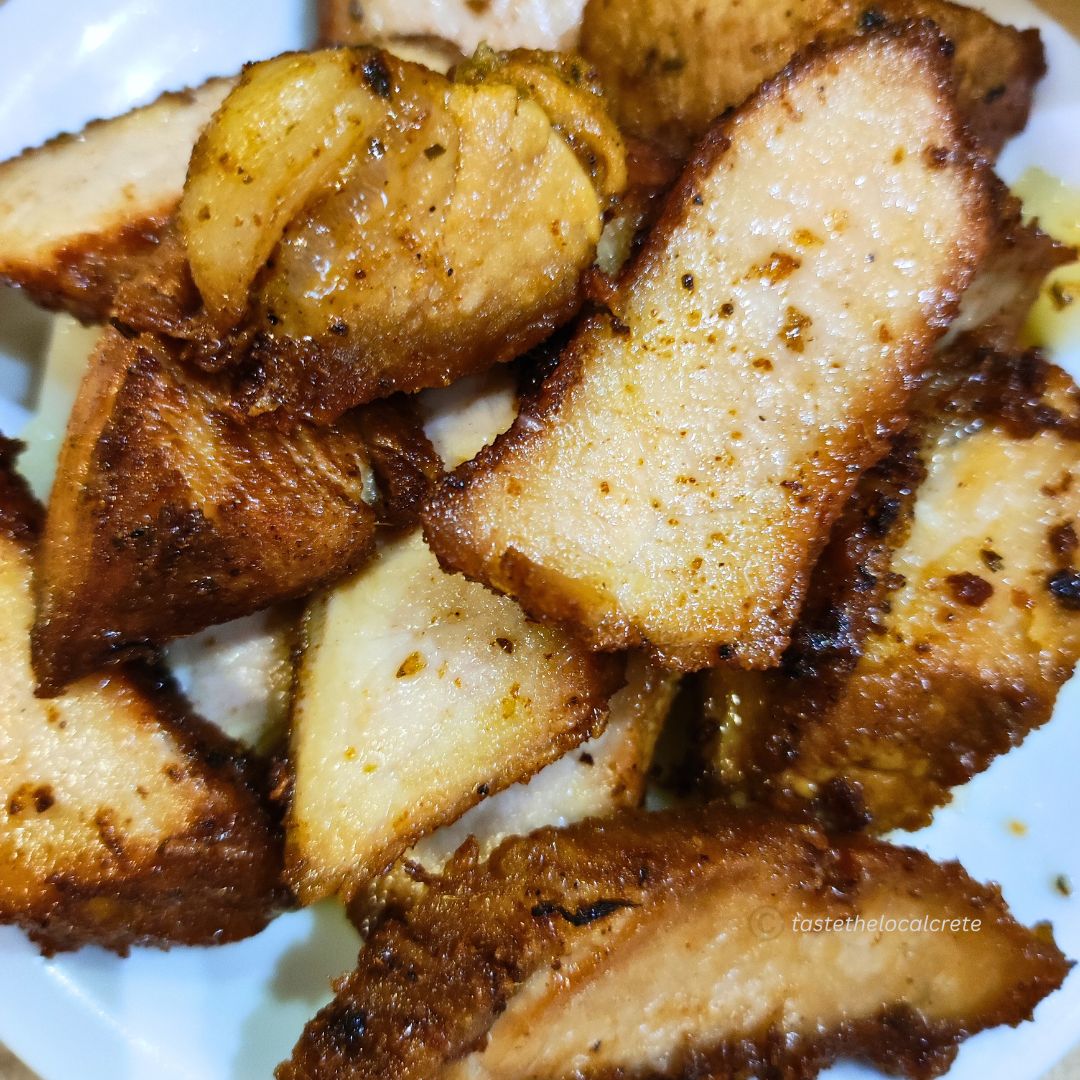
The “Black Meat” That’s Actually Smoked Perfection: Apaki
You see this dark, almost charcoal-colored meat on a plate and think something went wrong in the kitchen.
Nothing went wrong. This is apaki, and it’s one of Crete’s most prized traditional meats.
What makes apaki look so dark?
The smoking process:
- Pork or chicken gets marinated in vinegar with salt and spices for about two days
- Then hung over a fire for roughly 8 hours.
- The smoke comes from a mix of wood (olive, orange, lemon, cypress) plus wild herbs like thyme, sage, and rosemary.
This isn’t just about preservation (though that’s how it started centuries ago). The smoking creates layers of flavor you won’t find anywhere else.

How do locals eat it?
Most commonly as a meze – sliced thin and quickly pan-fried for a minute or two. The edges get crispy while the inside stays tender. Some tavernas serve it with Cretan pasta skioufichta, creating a smoky, hearty dish that tastes nothing like it looks.
Want to cook with apaki at home? The digital Cretan cookbook includes authentic recipes featuring this smoky meat that you can prepare on your smartphone, tablet, or laptop.
The texture surprises people. Despite looking tough, properly made apaki is lean and tender. The flavor hits you with smokiness first, then the herbs come through, followed by a slight tang from the vinegar marinade.
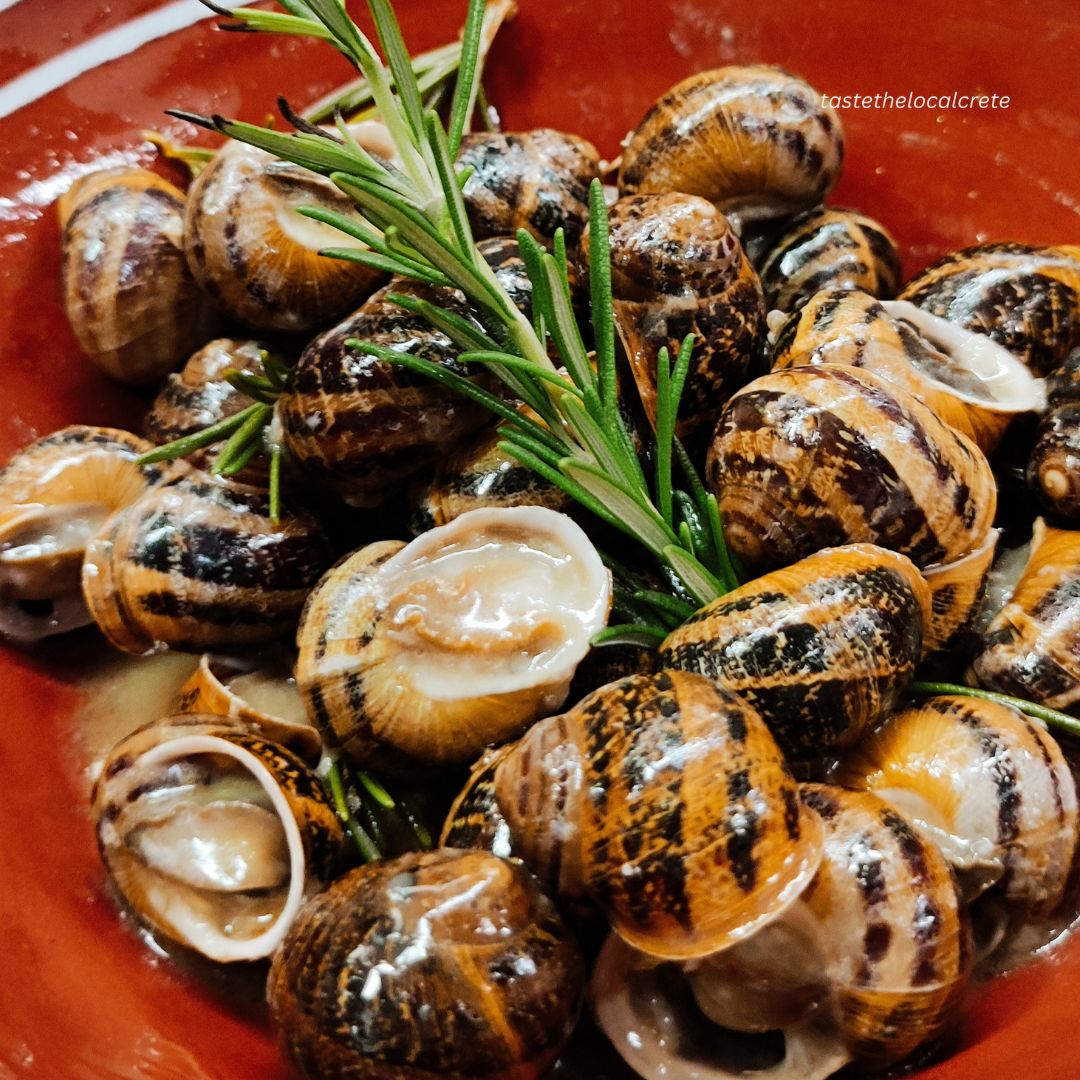
Snails Fried With Rosemary: Chochlioi Boubouristi
The name tells you how they’re cooked
Chochlioi boubouristi means “snails that bubble and sizzle.” The name comes from how they’re placed in the pan – with their shells facing downward (abouboura). You coat them in flour, fry them in hot olive oil, and listen for that bubbling sound. That’s how you know you’re doing it right.
The classic preparation? Rosemary and red wine vinegar. The herbs give them an aromatic punch while the vinegar cuts through any richness.
Snails cooked in red wine vinegar and rosemary (chochlioi boubouristoi) is a core dish of Cretan cuisine. But there are lots of other recipes with snails to taste on the island.
You’ll find snails cooked as a stew with wild greens (horta) and potatoes, snails cooked with xinochondros trachanas (wheat grains made out of sour milk), or cooked in tomato sauce with onions (stifado).
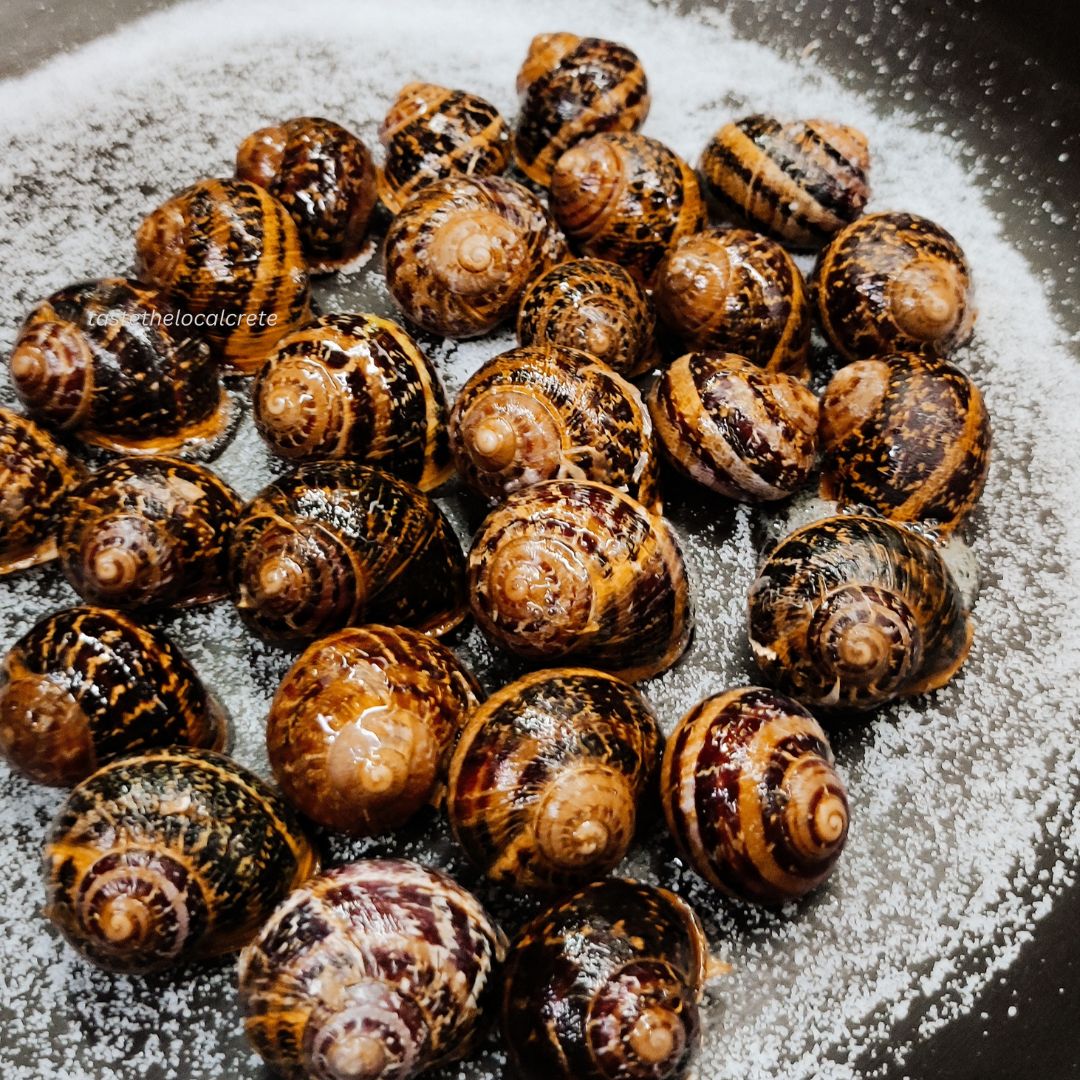
Why Cretans love snails
High protein, low fat, packed with iron. Locals have been eating them since Minoan times – we’re talking thousands of years of snail consumption here.
They’re not slimy or weird-textured like you might fear. Done right, they’re crispy on the outside with a tender, almost mushroom-like texture inside.
The key is freshness. Cretans traditionally collect snails after rain, when they come out of hiding. Spring is prime snail season.
Don’t knock it until you try it. These “weird” Crete foods often become the dishes you remember most.
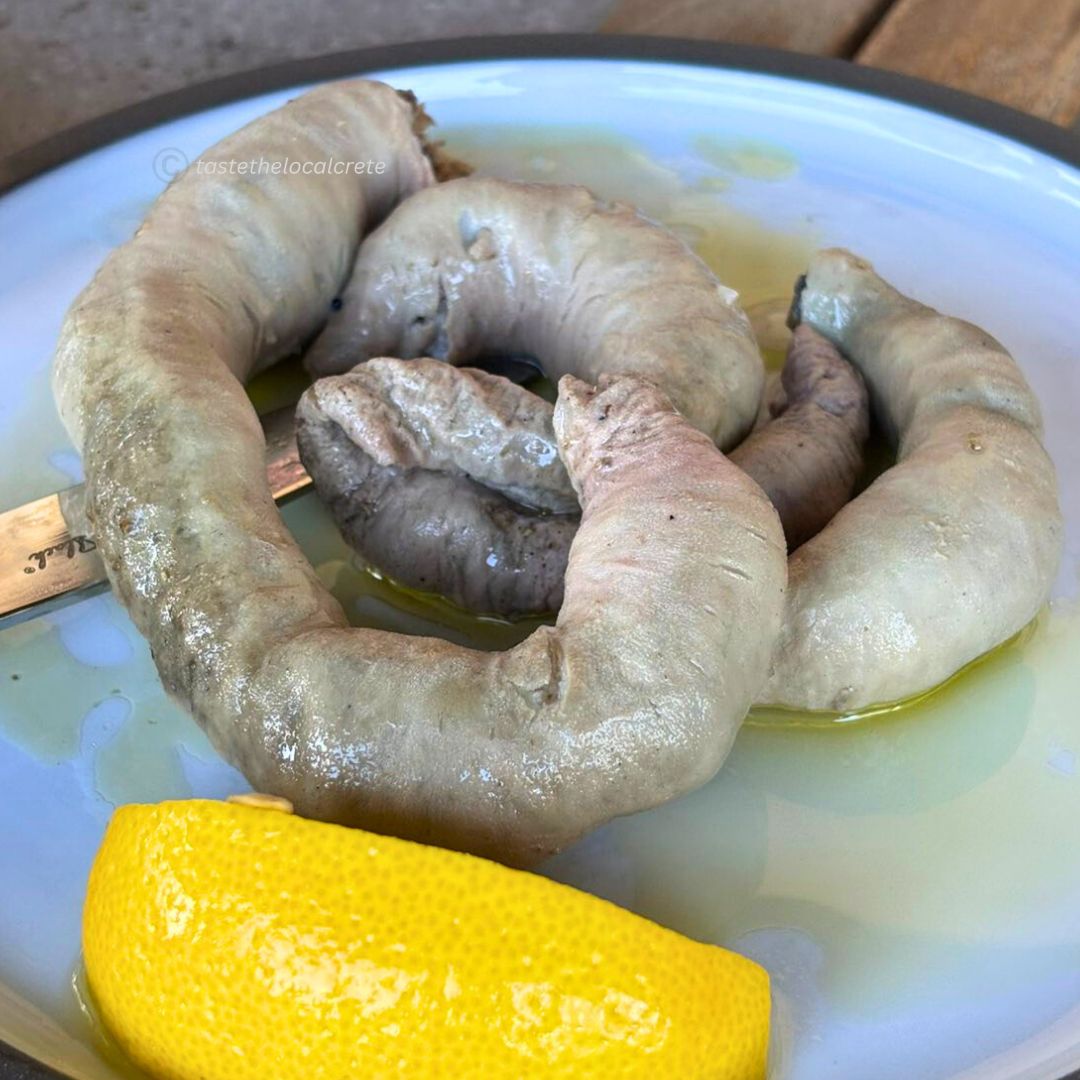
Stuffed Intestines That Test Your Courage: Omathies
Omathies look intimidating. Sausage-shaped bundles of stuffed intestines, boiled until tender. But here’s the thing, you can’t judge a book by its cover.
What’s actually inside?
The filling surprises most people. Pork offal (liver, heart, spleen) mixed with rice or xinochondros trachanas, plus dried fruits like raisins or currants, almonds, and spices. Some versions add cinnamon, orange peel, or wild herbs.
Sweet and savory in one bite. That’s the Cretan way.
The intestines get cleaned thoroughly, soaked in lemon water or vinegar, then stuffed with the mixture. Everything gets boiled together for about an hour until the sausages are tender.
The flavor profile
Think rich, slightly sweet, with warm spices. The offal provides depth, the dried fruit adds sweetness, and the spices tie it all together. Nothing goes to waste in traditional Cretan cooking.
You’ll mainly find omathies at traditional tavernas in eastern Crete that still make them the old way.
Not every taverna serves them. When you spot omathies on a menu, it usually means you’ve found a place that respects old cooking traditions.
Will you try them?
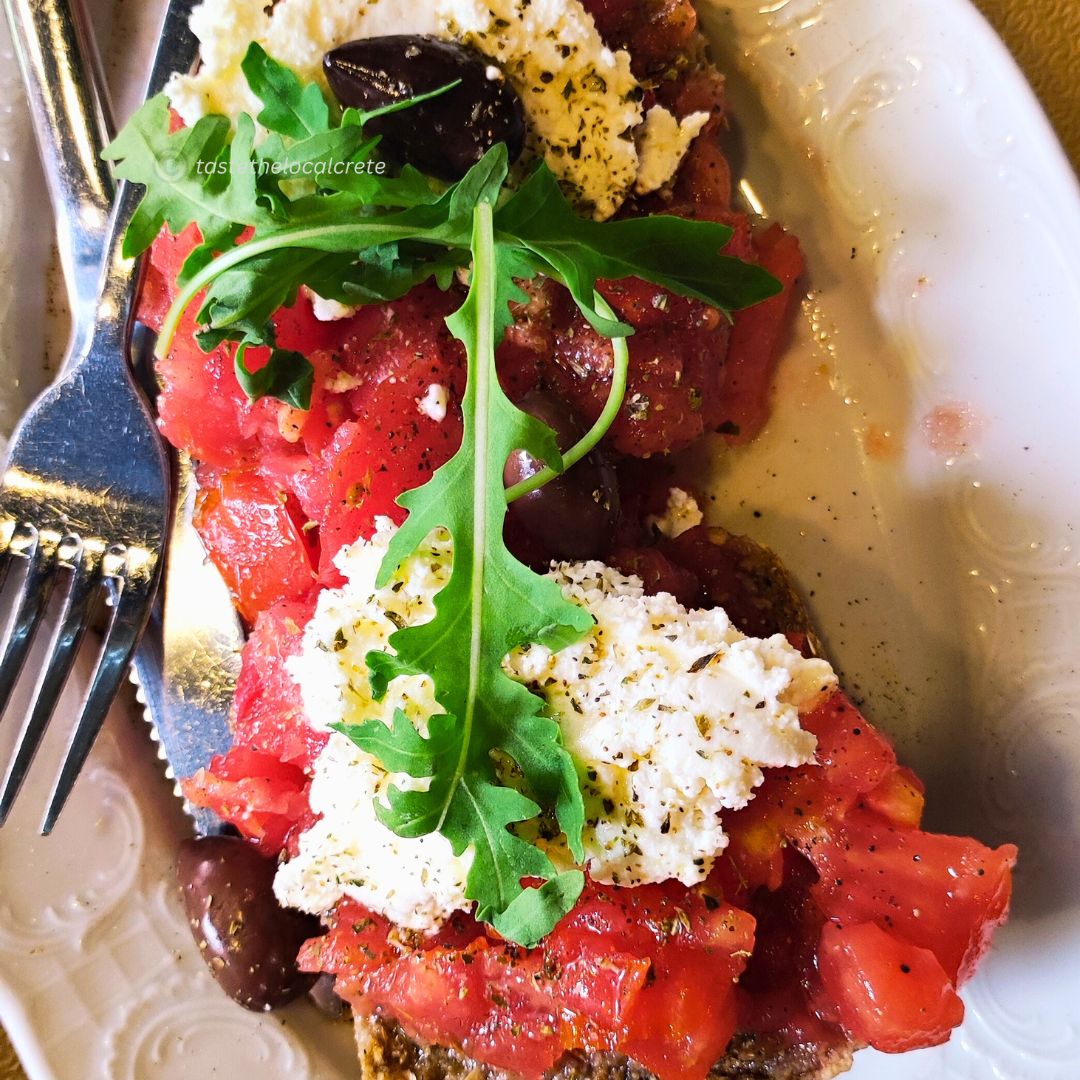
Frequently Asked Questions
What is the traditional food in Crete?
Traditional Crete food focuses on simple, seasonal ingredients prepared with minimal fuss.
You’ll find dishes built around olive oil, wild greens, local cheeses, and fresh vegetables. Meat appears in cooking, but vegetables and pulses play starring roles too.
Core Crete foods include dakos (barley rusk with tomatoes and cheese), various pies filled with greens or cheese, Cretan pasta like skioufichta, and slow-cooked meat dishes. Everything relies on what’s available locally and in season.
The cooking methods matter as much as the ingredients. Pan-cooked pies, slow-roasted meats, and simple grilled preparations let quality ingredients shine without heavy sauces or complicated techniques.
What is Crete’s national dish?
Crete doesn’t have one single “national dish” – the island’s food culture is too diverse for that.
But if you had to pick dishes that best represent Cretan cuisine, dakos would top the list. This simple combination of barley rusk, tomatoes, olive oil, and local cheese appears everywhere from beach tavernas to mountain villages.
Kalitsounia (small pies with cheese or greens) also ranks high. These hand-held pies showcase local cheese varieties and wild greens that grow only in Crete.
Some argue for antikristo (meat cooked opposite the fire) or gamopilafo (wedding rice) as the most traditionally Cretan. The truth is, each region has its specialties that locals consider the “real” Cretan food.
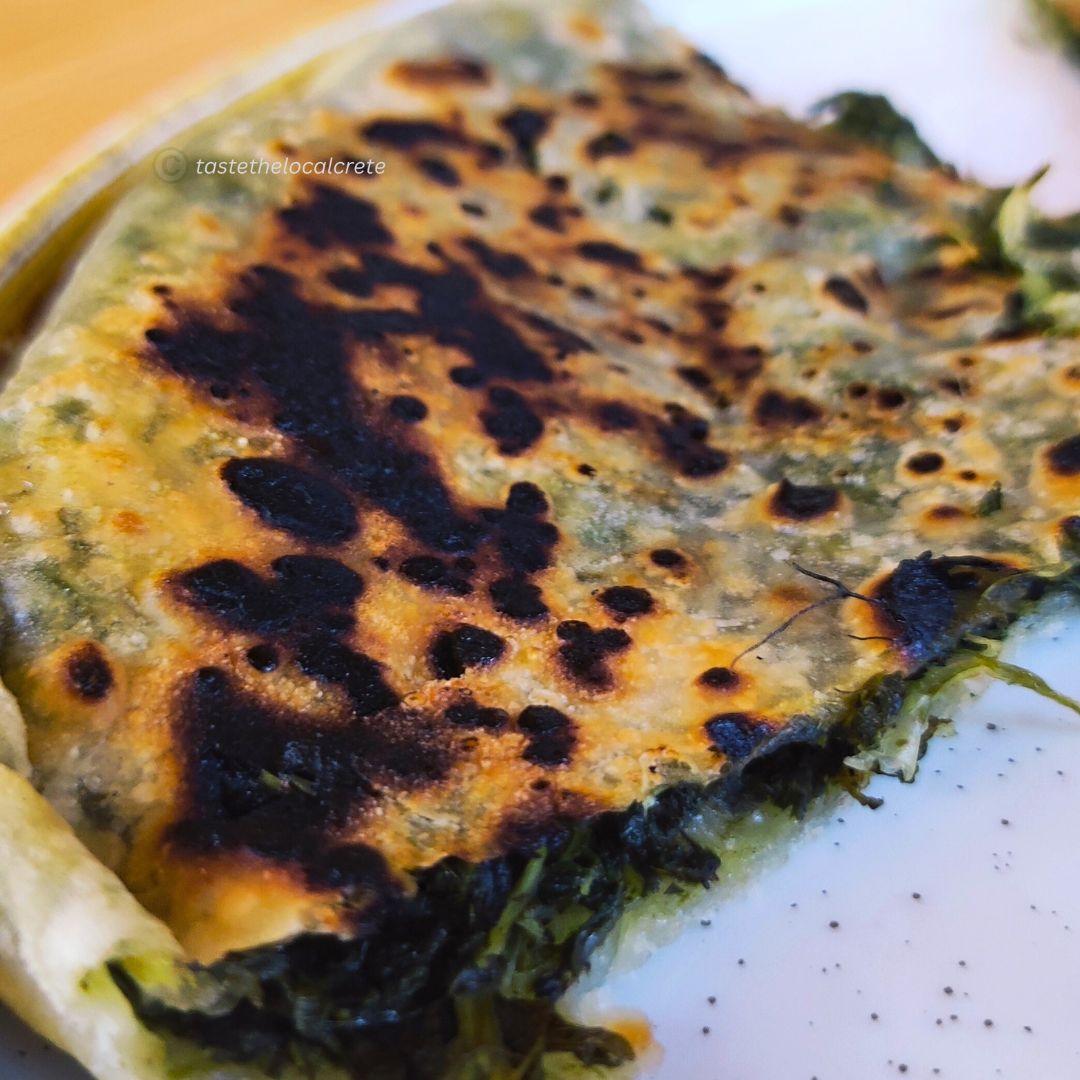
What is the difference between Cretan and Greek food?
Cretan cuisine is Greek food, but with distinct characteristics that set it apart from mainland cooking.
The biggest difference? Extra virgin olive oil usage. Cretans use way more extra virgin olive oil than other Greek regions – about 25 liters per person annually. This generous use of quality fat defines many dishes.
Cretan cooking also relies heavily on wild greens and herbs that grow only on the island. These 170+ endemic plants give Cretan dishes flavors you won’t find elsewhere in Greece.
The approach to meat differs, too. While mainland Greece features more lamb and beef dishes, Crete traditionally used meat sparingly, focusing instead on vegetables, pulses, and dairy from free-grazing animals.
Preparation methods vary as well. Many Cretan pies are pan-cooked rather than oven-baked. Smoking and curing techniques like those used for apaki are more common in Crete than on the mainland.
Is Crete good for food?
Absolutely. Crete just won the European Region of Gastronomy 2026 title for good reason.
The island produces exceptional ingredients you can’t find anywhere else: 11 indigenous wine varieties, 14 protected cheese types, and unique extra virgin olive oils that win international awards.
Food quality here stems from local production. Most tavernas use vegetables from nearby gardens, cheese from local shepherds, and olive oil pressed from trees that might be thousands of years old.
The Mediterranean diet that nutrition researchers praise? It’s based on the traditional Cretan way of eating.
But it wasn’t just about what they ate, it was about the quality of their high-fat intake diet rich in antioxidants with no processed foods, the source of their food (meat and cheese came from goats and sheep grazing freely on Crete’s mountains, feeding on indigenous wild herbs), and the Cretan lifestyle where people maintained physically active lives daily.
You’ll eat well whether you stick to familiar dishes or try the “weird” ones.
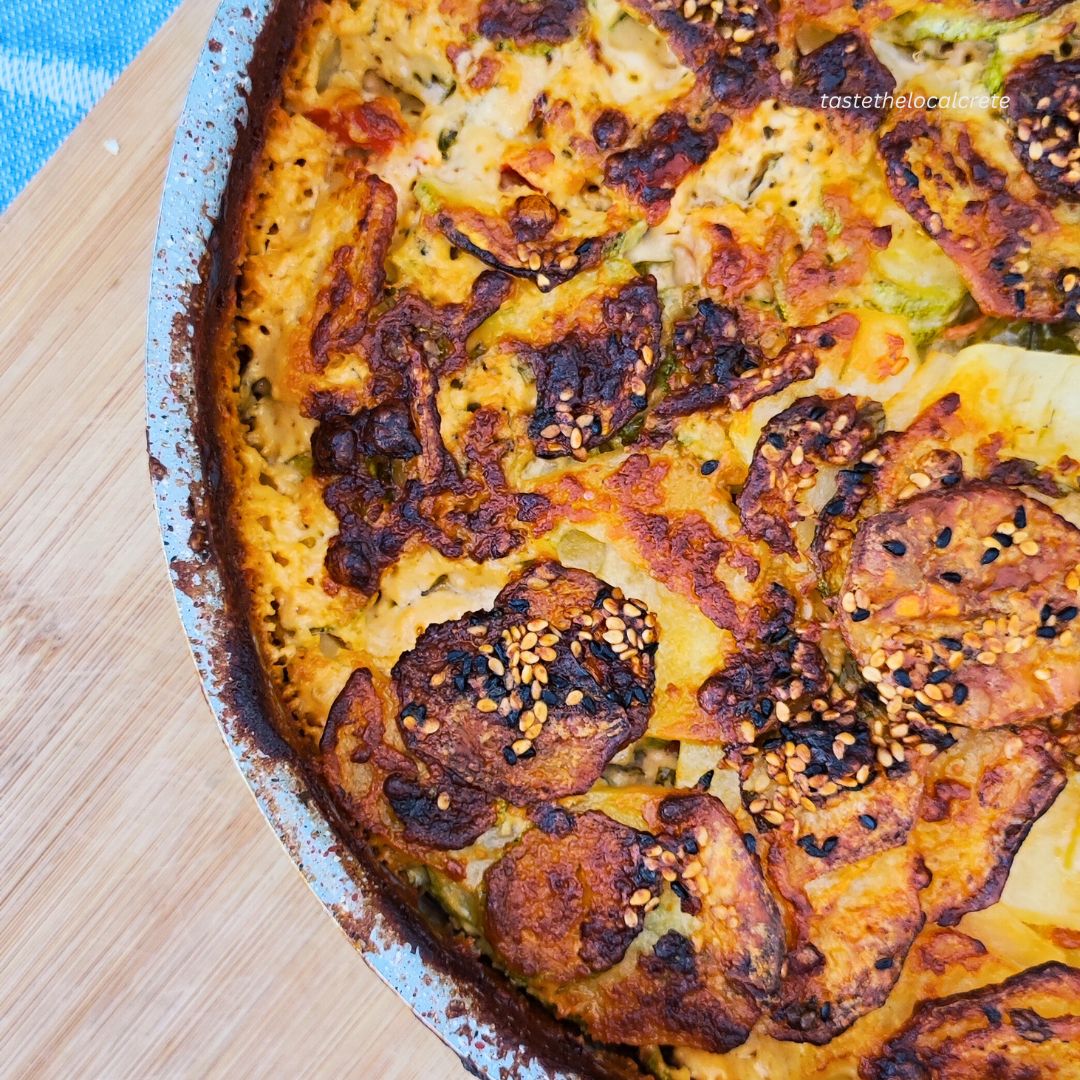
From Weird to Wonderful: Your Cretan Food Adventure Awaits
The beauty of traditional Crete food lies in its honesty. No fancy techniques or Instagram-worthy plating. Just quality ingredients, simple preparations, and flavors that have satisfied islanders for thousands of years.
Ready to go beyond the “weird” and explore everyday Cretan cooking?
The digital Cretan cookbook created by Taste the Local Crete brings you 50+ easy-to-prepare Crete foods from the daily cuisine of Crete. These aren’t the intimidating dishes; they’re the real meals locals actually cook at home.
You can use this digital recipe guide easily on your smartphone, tablet, or laptop, making authentic Cretan cooking accessible no matter where you are.
Start with your free recipe guide and begin cooking the Cretan way!
FREE LOCAL'S GUIDE TO CRETE
Get my free 25-page Cretan guide with insider tips and answers to your most common questions. Written by someone who actually lives here.

